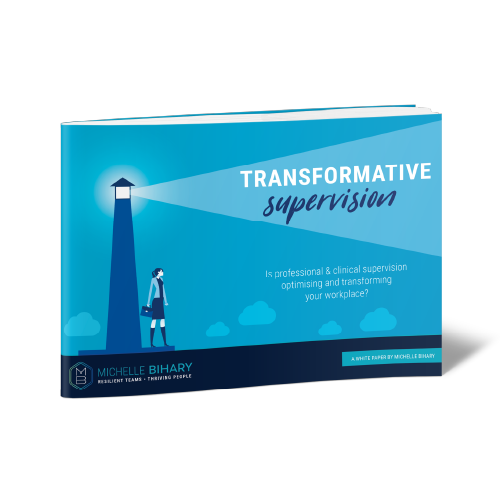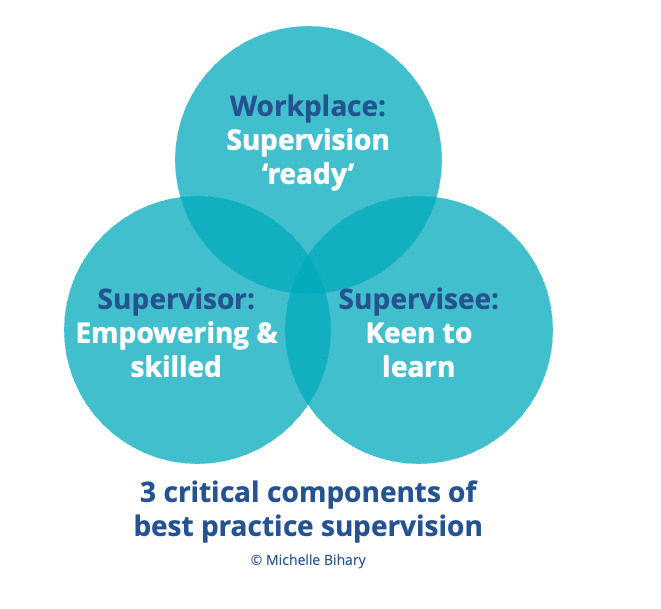
Professional Supervision Insights Surveys
Do your supervision practices align to best practice?
Professional and clinical supervision is one of the most customised, recognised and well-researched methods for enhancing the professional skills and support needs in our sector. It is critical that supervision is high-quality, evidence based, and aligns with best practice.
However, supervisory experiences can vary wildly across a range of four levels from toxic, benign, positive to transformative.
At best, supervision can be a highly transformative experience that provides significant benefits to the supervisee, supervisor, and workplace.
If the evidence is ignored, supervision can be a waste of time or even worse, an invalidating, traumatic or toxic experience.
I am thrilled to be able to offer valuable tools to assist supervisors, supervisees and workplaces support excellence in supervision practice.
I have created 3 surveys in order to review supervision at these levels:
Workplace - How aligned is your workplace supervision to best practice?
Supervisor - How aligned is your supervision to best practice?
Supervisee - How aligned is your approach as a supervisee to best practice?
Supervision Insights Surveys
-

Workplace survey
If you are a health leader, practice owner or practice manager take the survey below to gain clarity around what arrangements and policies you should have in place in your workplace to ensure:
- You are “supervision ready”
- Supervisors and supervisees get the most out of their sessions, and
- Your clients and everyone in the workplace benefits from this explicit support.
-

Supervisor Survey
Click the button below to take the supervisor survey to review the key elements of your supervisory role in supporting the professional learning and development of your supervisees and in reflecting on your role in the supervisory relationship.
-

Supervisee survey
Click the button below to take/share the Supervisee survey as an opportunity for supervisees to consider their own agency in making the most of their supervisory experiences, highlighting areas for potential growth and greater engagement.
Are you and your workplace engaged in supervision aligned with best practice?
Best practice supervision contributes to the quality of clinical services, as well as sustainability, in terms of both staff engagement and retention.
As supervisory experiences can vary wildly from toxic to transformative, these insights surveys aim to highlight ways the workplace/supervisors/supervisees can build their supervisory skills and optimise the supervisory experience aligned with best practice.
The expectation is not to be perfect, but it is to acknowledge that working towards best practice supervision is an ongoing process for every workplace/individual.
Best practice supervision includes 3 critical components:
a supervision ready workplace – that has a psychologically safe, learning culture with solid policies and infrastructure for supervision
a supervisor who is empowering, psychologically safe, committed, and skilled in supporting learning and growth in themselves and their supervisees
a supervisee who is keen and open to learning, willing to work with a supervisor and invest in learning and professional development
The workplace, supervisors and supervisees have equally critical roles in supervision. No party can do successful supervision alone. If you are willing, but the other critical components are not, you will find it frustrating and challenging.
-
Professional and clinical supervision is one of the most customised, recognised and well-researched methods for enhancing the professional skills and support needs in our sector. Therefore, it is critical that supervision is high-quality, evidence based, and aligns with best practice.
Professional and Clinical Supervision is a process of learning and support, designed to build self-directed learners and workforce capacity through practice skill development and reflective learning.
-
Extensive research in professional and clinical supervision, workplace learning, psychological safety, interpersonal neurobiology, emotional intelligence, professional burnout and workforce wellbeing provides a sound foundation for building supervisory practice.
-
Supervisory experience can vary wildly across a range four levels from toxic, benign, positive to transformative.
At best, supervision can be a highly transformative experience that provides significant benefits to the supervisee, supervisor, and of course to the workplace. If the evidence is ignored, supervision can be a waste of time or even worse, an invalidating, negative, traumatic, or toxic experience.
Additional Supervision Resources
-

Transformative Supervision Whitepaper
Is professional and clinical supervision optimising and transforming your workplace?
Best practice supervision requires skilled supervisors and supervisees who are educated in supervision as well as a workplace that is aligned with a learning culture and learning principles. This white paper explores the value of professional and clinical supervision and ways that workplaces can optimise this investment.
-

Transforming Supervision Article
Are you a compulsive problem solver?
The old adage “give someone a fish and you feed them for a day, teach them to fish and you feed them for a lifetime” rings so true when it comes to refining our role as professional and clinical supervisors.
Imagine a world where supervisors are no longer the superheroes swooping to the rescue, ready to solve every supervisee’s problem.
Instead, they're the wise guides holding space for reflection and discovery, transforming supervisory conversations, into a landscape of endless learning opportunities.
-

Best practice supervision webinar
This 55 minute webinar summarises the range of supervisory approaches and explores what drives each of these in a workplace. Michelle also shares ways workplaces can take steps to align supervision with best practice.
SURVEY FEEDBACK




